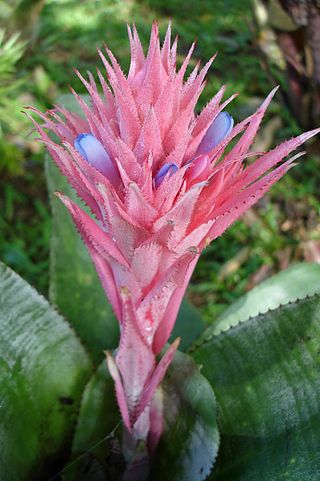Phenology is the study of periodic events in biological life cycles and how these are influenced by seasonal and interannual variations in climate, as well as habitat factors.

Hydroxyzine, sold under the brand names Atarax, Vistaril and others, is an antihistamine medication. It is used in the treatment of itchiness, insomnia, anxiety, and nausea, including that due to motion sickness. It is used either by mouth or injection into a muscle.

Morrens is a municipality in the district of Gros-de-Vaud in the canton of Vaud in Switzerland.

Carbinoxamine is an antihistamine and anticholinergic agent. It is used for hay fever, vasomotor rhinitis, mild urticaria, angioedema, dermatographism and allergic conjunctivitis. Carbinoxamine is a histamine antagonist, specifically an H1-antagonist. The maleic acid salt of the levorotatory isomer is sold as the prescription drug rotoxamine.

Vriesea is a genus of flowering plants in the botanical family Bromeliaceae, subfamily Tillandsioideae. The genus name is for Willem Hendrik de Vriese, Dutch botanist, physician (1806–1862). Its species are widespread over Mexico, Central America, South America and the West Indies.

Aechmea is a genus of flowering plants in the family Bromeliaceae. The name comes from the Greek aichme, meaning "spear". Suggested pronunciations include EEK-me-ə and eek-MEE-ə. Aechmea comprises eight subgenera and around 250 species distributed from Mexico through South America and the Caribbean. Most of the species in this genus are epiphytes.
Ulmus × hollandica 'Pitteurs' or 'Pitteursii', one of a number of hybrid cultivars arising from the crossing of the Wych Elm Ulmus glabra with a variety of Field Elm Ulmus minor, was first identified by Morren as l'orme Pitteurs (1848). Elwes and Henry (1913) and Krüssmann (1976) listed it as an Ulmus × hollandica cultivar. It was named after the landowner Henri Bonaventure Trudon de Pitteurs of Saint-Trond, near Liège, Belgium, who discovered and first propagated the tree on his estate.

The hybrid elm cultivar Ulmus × hollandica 'Superba' is one of a number of intermediate forms arising from the crossing of the Wych Elm U. glabra with a variety of Field Elm U. minor. Boulger tentatively (1881) and Green more confidently (1964) equated it with a hybrid elm cultivated in the UK by Masters at Canterbury in the early 19th century, known as "Masters' Canterbury Seedling" or simply the Canterbury Elm. Loudon examined a specimen sent by Masters and considered it a hybrid, calling it U. montana glabra major.
Ulmus × hollandica 'Folia Rhomboidea' is one of a number of cultivars possibly arising from the crossing of the Wych Elm Ulmus glabra with a variety of Field Elm Ulmus minor. First mentioned by Morren in 1851 as U. campestris latifolia, foliis rhomboides.

Hohenbergia is a genus of plants in the family Bromeliaceae, subfamily Bromelioideae. It is native to the West Indies, the Yucatán Peninsula, and northern South America.

Nidularium is a genus in the plant family Bromeliaceae, subfamily Bromelioideae. Named to describe the nestling characteristic of the inflorescence, all the species are endemic to Brazil. Commonly confused with Neoregelia which they resemble, this plant group was first described in 1854.

Fedrilate is a centrally acting cough suppressant. It was patented as a mucolytic by UCB in 1971, but was never brought to market in the US. In the Netherlands, it has been marketed as Tussefan and in combination with guaifenesin as Tussefan expectorans.

Bromazine, sold under the brand names Ambodryl, Ambrodil, and Deserol among others, also known as bromodiphenhydramine, is an antihistamine and anticholinergic medication of the ethanolamine class. It is an analogue of diphenhydramine with a bromine substitution on one of the phenyl rings.
Carbinoxamine/pseudoephedrine is an antihistamine and decongestant combination, marketed as Rondec, Ceron and Coldec. It contains two active ingredients: carbinoxamine and pseudoephedrine.

Charles François Antoine Morren, was a Belgian botanist and horticulturist, and Director of the Jardin botanique de l’Université de Liège.

Charles Jacques Édouard Morren was a Belgian botanist, professor of botany and director of the Jardin botanique de l'Université de Liège from 1857 to 1886. His special field of study was the Bromeliaceae on which family he was the recognized authority. He was the son of Charles François Antoine Morren.
Thomas Morren was an English international footballer, who played as a centre half.
François Morren was a Belgian sprinter. He competed in the men's 400 metres at the 1920 Summer Olympics.

The wych elm cultivar Ulmus glabraHuds. 'Superba', Blandford Elm, with unusually large leaves, was raised by Gill's of Blandford Forum, Dorset, in the early 1840s as Ulmus montana superba and was quickly distributed to other UK nurseries. It was confirmed as a form of wych, and first described, by Lindley in The Gardeners' Chronicle, 1845, later descriptions being added by Gill (1845) and Morren (1848), who called it U. montana var. superba. Morren had adopted the name 'Superba' from the Fulham nurseryman Osborne in 1844, who supplied him with the tree – presumably one of the nurseries supplied by Gill. Morren states that 'Superba', already in cultivation in England, was introduced to Belgium by Denis Henrard of Saint Walburge, Liège, that in 1848 it had been present in Belgium for only three years, and that this variety was the one described as 'Superba' by Osborne, whom Henrard had visited at his nursery in Fulham in September 1844. 'Blandford Elm', with leaves of the same dimensions, was soon for sale in the USA.

Tillandsia subg. Tillandsia is a subgenus of the genus Tillandsia.















